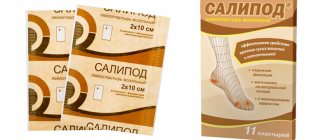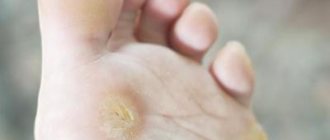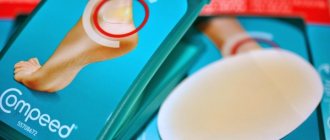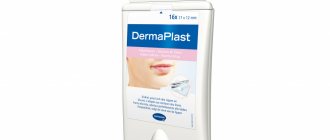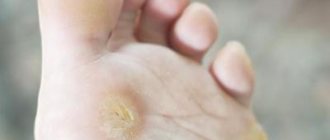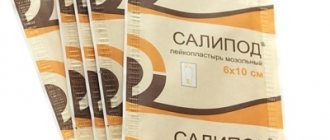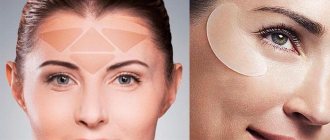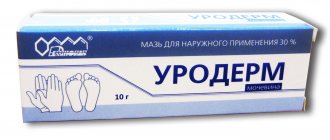Calluses or hyperkeratoses are local changes in the skin associated with exposure to damaging factors on an area of the body.
Literally translated, “hyperkeratosis” means “excess of keratin,” a substance that causes hardening.
The skin loses its elasticity, becomes less sensitive to external influences, and feels rough to the touch.
Defects in ICD10 are allocated to a special nosological group L84 - “Calls and calluses”.
Mostly calluses form on the skin of the hands and feet, where the epidermis (skin) contains, among others, a shiny layer.
It provides increased skin density as an adaptation to external pressure or friction.
As a result, the skin becomes denser in defense and calluses form.
Preventing the formation of calluses
- hygiene of the skin of the feet and hands, timely pedicure
- maintaining sufficient skin hydration
- avoid wet hands and feet (socks, gloves, prolonged exposure of hands and feet to water)
- comfortable shoes that fit well, with a wide toe and a hard heel
- shoes with dense soles with some elevation in the heel area, well-finished edges, smooth insoles
- changing shoes several times during the season
- massage of hands and feet, therapeutic exercises
- thorough treatment of soft and dry calluses, avoiding complications
- avoid microtraumas, including permanent traumatization by a foreign body
- don't cut calluses
- use protective plasters if there is a risk of callus formation
If calluses appear, contact the author of this article, a dermatologist in Moscow with many years of experience.
Patches for dry calluses
Patches often used for dry calluses should contain emollients and moisturizers and substances: urea or salicylic acid.
A patch with salicylic acid eliminates the stratum corneum, relieves local inflammation, and prevents the development of cracks.
The use of the patch in patients with allergic reactions is possible only after consulting an allergist.
The Leiko dry calluses patch is a fabric strip with a membrane impregnated with salicylic acid.
The application time for one patch is 2 days.
The Urgo salicylic patch features a foam pad that protects healthy skin from the effects of salicylic acid.
Perforation ensures the prevention of the “greenhouse effect”, preventing macerations.
Time to use the patch is 24-48 hours.
A clear disadvantage of the product is the risk of allergic reactions.
Hands remain a little sticky after use due to the adhesive base of the patch.
Salicylic acid is found in Chinese Jiyantie and Shulyangsuan patches along with phenol.
Has an antiseptic, softening, analgesic effect.
The use of patches in patients with diabetes and children is excluded due to high concentrations of active substances.
Plasters for dry calluses and corns are manufactured by the following companies:
- Dr. House
- Johnson & Johnson (Compeed dry callus patch)
- Hartmann (Cosmos patch for dry calluses)
Compeed and Cosmos foot callus patches have a translucent texture.
This allows them to be used on the hands, face, back of the foot, little finger).
In addition to softening, the patch provides an environment that stimulates active division and growth of new epidermal cells.
Luxplast spray patch is most often used for soft calluses.
But it is able to create a protective film that protects dry callus from further friction.
You can also use Foretal Plus cream, containing 25% urea in combination with phospholipids.
Plasters for core calluses
For core calluses, the choice is usually the Salipod patch.
It contains salicylic acid, precipitated sulfur, lanolin and natural rubber.
A fragment is manually cut out of the patch, the shape and diameter corresponding to the callus core.
It is applied to it and secured on top with an adhesive plaster for 48 hours.
If there is no effect, Salipod is reused.
This patch is very effective, but has a number of contraindications.
These are pregnancy, early childhood, allergic reactions, open wounds and moles at the site of callus formation, elderly and senile age, diabetes mellitus.
Care must be taken not to allow the Salipod patch to attach to healthy skin: burns are possible.
Compeed and Cosmos patches are used for ingrown calluses.
They are made using hydrocolloid “second skin” technology, which prevents infection after removal of the rod.
How to treat calluses at home
The best way to treat calluses at home, without involving a doctor, is to use special patches.
Pharmacies often offer a variety of products targeting different types of calluses.
Each patch has instructions included in the packaging or printed directly on it.
Mode of application:
- The limb should be lightly steamed and blotted dry.
- Lubricate the healthy part of the skin around the callus with baby cream or Vaseline.
- Remove the protection, place the membrane impregnated with the medicinal composition strictly on the skin defect
- Fix the patch and wear for 1-2 days
Which plaster for calluses is better?
- the one that is applied to the callus in a timely manner
- corresponds to the type of callus
- Fits tightly and is easy to remove
- does not cause allergic reactions
If the patch for calluses does not provide the required effect, you should contact a podologist or podiatrist, a specialist in therapeutic (medical) pedicure.
A cosmetologist or cosmetology nurse will also help get rid of defects.
In more serious cases, it is necessary to visit a dermatologist, mycologist or simply a surgeon
Patches for soft (wet) calluses
The patch is aimed at preventing wound infection, protecting damaged skin, resolving blisters and relieving pain.
Such patches are made from hydrocolloid materials that act like a “second skin.”
It is strictly contraindicated to open the blisters on your own.
This leads to infection and, upon healing, to disfigurement of the skin area.
If the bubble has opened, the skin around the wound is treated with hydrogen peroxide or furatsilin solution.
A medical plaster or self-adhesive bandage with a bactericidal effect is applied to the wound.
Compeed (manufactured by Johnson & Johnson) and Cosmos (manufactured by Hartmann) patches are made from colloidal substances that promote healing.
Plaster Dr. House has a hydrocolloid pad.
The application time for one patch is 24 hours.
Luxplast spray patch for wet calluses creates a hydrocolloidal waterproof protective film by spraying, drying within 30 seconds.
Apply once a day until the wound is completely healed.
Used in the treatment of wet calluses in children.
Liquid patches Emplasto, Gehwol (gel patch - callus pencil) are applied to the skin, forming a protective film.
The liquid patch contains mild astringents and antiseptics; it can be applied even to a child.
